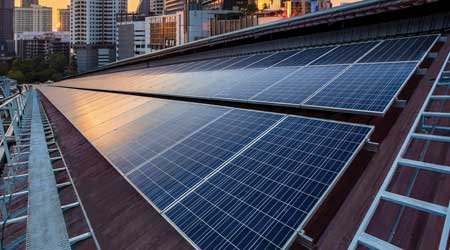How Renewable Energy Contributes to Organization's Green Goals
Though most organizations won't get all or most of their electricity from onsite renewable energy generation, other options can help close the gap, including purchasing off-site renewables.
It is a relatively rare commercial facility that can meet all of its power needs with on-site renewable energy generation. Purchasing renewable energy generated off-site is one way to still pursue emissions-reduction goals. In Los Angeles, Le already purchases all power for the county that is not generated onsite through renewable energy aggregators. "We're already cleaner than the rest of the grid," says Minh Le, general manager for energy and environmental services for the County of Los Angeles internal services department.
Multi-tenant property owners face particular challenges when pursuing renewable energy for their faculties. Differing lease structures, access to tenant energy use, and figuring out ways to pass back costs for capital improvements in an equitable way can all complicate the situation.
Andy Gutman, president of the Farbman Group in Michigan, recently signed onto the DTE Energy MIGreenPower program for his properties, allowing between 5 and 100 percent of the site's electricity to be sourced from renewable power.
"We're trying to make this neutral to our clients," says Gutman. "The costs of this (program) can be shared, but the costs are very minimal."
Currently the infrastructure for the program is being built out, with full rollout in 2023. In the meantime, Gutman says dashboards and other software that is now more robust and readily available can help property owners get the visibility they need into energy use in their buildings to inform energy efficiency decisions.
Purchasing off-site renewable energy is a convenient and accessible way to get involved with renewables. Buying power at wholesale for wind or solar farms far away from commercial centers is cheaper, on a per kWh basis, says Le. "It makes a lot of sense to do that, financially," he says. But it is not a solution without consequences.
Off-site generation is not as efficient as on-site generation due to transmission line loss. In the United States, transmission losses average 7 percent, according to Pearce. Off-site generation also does not help increase a facility's resilience and is a less direct way to address climate change.
"If you purchase off site, you're still using all that power," says Jeremy Macdonald, global energy and sustainability director, with ISS A/S. "But you're supporting driving our economy towards more renewable sources. It's an important intermediary step."
Planning ahead
In the near future, market pressures will demand more engagement with renewable energy generation. One factor Macdonald says is driving renewable energy among his clients is the competitive advantage of becoming carbon neutral. Companies have to quantify their emissions when reporting to their investors. Scope 1 and 2 emissions are now commonly reported in the top 1,000 companies, he says, and these emissions have to do with a company's own generation and any power purchased.
Scope 3 emissions have to do with the supply chain. "It's a much bigger chunk, but it's much harder to count," Macdonald says. While reporting on Scope 3 emissions is just getting started now, he expects it to pick up as investors begin to require the information. "Coming down the road, if you're a clean company as far as your energy, you have a big advantage over your competitors," says Macdonald. One of his accounts, a large pharmaceutical company, already has a goal of reducing their Scope 3 emissions by 15 percent, which means all of their suppliers need to improve their emissions or potentially risk losing the contract.
Another factor facility managers should keep in mind with renewable power is the pending increased demand at their facilities from electric vehicles. One forecast from CleanTechnica expects a 70 percent increase year over year in 2021 for U.S. EV sales, with half a million new EVs across a whole fleet of new models, from pickups to supercars. Which means no matter what kind of facility you have, there will soon be more people looking for a place to juice up at work. Le says that adding a few EV charging stations won't make much of a noticeable impact on a facility's overall load profile. But he is expecting internal combustion engine vehicles to quickly become the minority in California. A recently signed state mandate calls for all new vehicle sales in the state to be emissions-free by 2035. As a result, Le is expecting an increase of electricity demand in his portfolio of municipal buildings by 30 to 50 percent.
"You have to plan for that," Le says. "You have to make sure your infrastructure is adequate." One bonus is that vehicle charging in government buildings would primarily occur during the day, and this is well-aligned with solar generation, he says.
Regardless of whether your facility is among the eco-elite or your facility hasn't had a green thought in its life, it is likely that adopting some mechanism of renewable energy will not be optional for much longer.
"The minimum requirements are increasing every year," says Macdonald. "Maybe it's still slow. But whatever that bar is, I think it's going up. Even if companies do the minimum, they're going to get dragged along to do better and better."
Related Topics:














